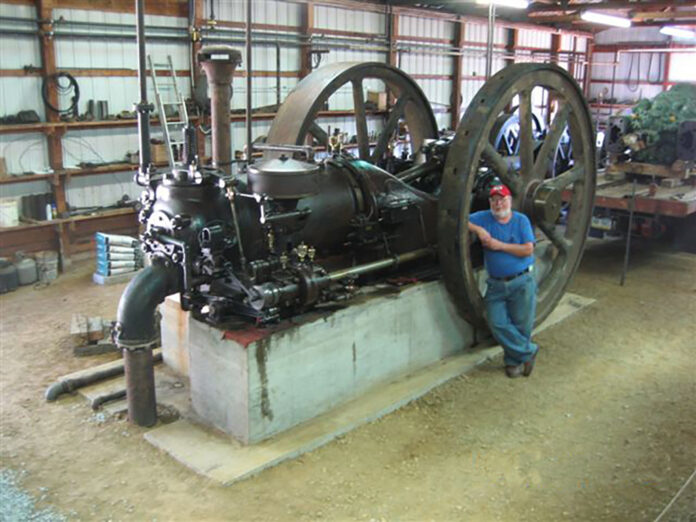
We met last month with my first article written for your pleasure, and I enjoyed recalling my life events for you. Since we are friends now, I would like to introduce you to the museum.
It is an interesting story, starting with one engine and becoming a world class collection. So, let’s take a look.
A humble beginning

International pick-up truck. (Paul Harvey photo)
Way back in 1958, I bought a 1 1/2 hp Hercules engine because I was fascinated with such an unusual machine. I was a sophomore in high school then — wow, that was 66 years ago! (Now, I’m pushing 80 and still going strong.) Little did I realize that the little Hercules would turn into a lifelong passion. Yep, it still runs well and is displayed in the front window of the Machine Works so everyone entering the grounds can easily see it. So a lot has happened during the many years.
School took me away a bit, but my love for these engines persisted. Attending West Virginia University, I became introduced to the oil fields and their engines, and a new world opened.
Not long after, I met Dr. John Wilcox, a brilliant historian and collector. Becoming friends, he took me to the Rough and Tumble Engineers show in Kinzer, Pennsylvania to see a myriad of wonderful machines in operation. My world had just changed.
A growing collection

As the collection grew, a building was needed. So in 1967, during a fall break from school, my Dad and I built a somewhat crude, 12-by-20-foot building to display the growing collection. We named it the “Engine House,” and it is now called the “Founder’s Building” having grown to be 24 by 56 feet. But that was just the beginning.
Back then, my Dad helped so very much, bringing home engines on my faithful International pick up truck. Over the years, the trucks became bigger, but always were very well used before they came here.
Soon, this hobby needed another building. So the “Big Barn,” or now the Power Tech Building, was erected in 1971. It housed my first very large engine at that time, the 125 hp twin cylinder Klein. It’s still there and still runs. Gosh, the Big Barn was filled so quickly!
The Power House followed in 1976. Another big engine came to be housed there — the 150 hp four cylinder Turner-Fricke and its alternator. Local and distant interest bloomed with the operation of these two engines, as well as many smaller ones.
Forming Coolspring Power Museum
About that time, the late John Kline, foreman of the Pittsburgh and Shawmut RR Diesel shop and a good friend of mine, suggested an organization be formed and shows scheduled. Soon, the Coolspring Hit and Miss Engine Society was born, and the first engine show here was staged in 1976. It was a small, but a huge success. Now known as CHAMES, the shows grew better and better, as the buildings, grounds and collections expanded.
By 1985, the collections and shows had grown to the point that the Coolspring Power Museum was formed. It became a 501(c)(3) tax-exempt organization with a board of directors and scheduled meetings.
About that time, John Wilcox partnered with me, and started moving some of his choice engines here. A new era had begun!
Offering a unique experience

Expansion was rapid and the shows grew in size and quality. The museum has had guests from over 46 states, as well as many countries abroad. All who’ve visited have had a good time as CPM is an operating museum — about 75% of our engines will operate for our displays.
Of the 35 buildings on 40 acres, most have gravel floors, but the engines run and operate so well. We like to display our machines in their “working clothes” and not fancy restorations. However, the two buildings housing the very rare are minimally heated for safe preservation.
Many other large engines came here, including the 300 hp Miller with four cylinders in an H configuration and a center flywheel. It was belted to its huge Ingersoll-Rand compressor. Also, here is the 65 hp Blaisdell combination compressor and engine residing in its original building, which is re-erected at the museum.
Why all the air? These “modern” machines operated the old steam engines in the oil field.
The Susong Building and Preston Foster Hall house some extremely early engines. One can sit back and enjoy a full scale, 1867, Otto Langen free piston replica engine. Included is a non-compressing Sombart rated at 5 manpower. There is an amazing array of slide valve engines, both horizontal and inverted.
The museum’s largest engine is the 600 hp Snow. Weighing 140 tons and measuring 75 feet long, it was a 20 year project for our volunteers. But now it runs so well again, after pumping natural gas for 80 years.
Coolspring Power Museum, from humble beginnings, has grown into a world class museum. Hosting two large events annually — one in June and the other in October — we display some very rare engines. This year will be our 39th year, and the featured engine will be the Foos. Additionally, the museum will host exhibitors from all corners of the country, as well as as a flea market and yummy food. It’s a very friendly experience.
Look at our website at coolspringpowermuseum.org or call 814-849-6883 for all current information. I hope you visit us and enjoy!












